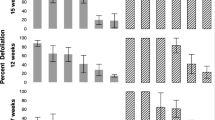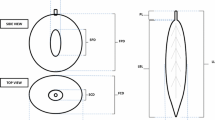Abstract.
Solanum phureja clone 1-3 and S. chacoense clone 80-1 have a zero and high leptine content in their foliage, respectively. An F1 hybrid (CP2) was intermediate for the trait, but self-incompatible. Two reciprocal backcross families, PBCp (phu 1-3 × CP2) and PBCc (CP2 × phu 1-3), and a family of monoploids derived by anther culture of CP2, were characterized for leptine as the aglycon, acetylleptinidine (ALD), content in leaves by gas chromatography. ALD was present in 43 of 87 genotypes in the PBCp backcross, implying simple genetic control by a dominant gene. However, the ALD levels were low compared to CP2. In the PBCc backcross, only 7 of 42 genotypes expressed ALD at a level generally higher than in PBCp. This ratio was significantly different from the 1:1 segregation observed in the reciprocal backcross and suggests a cytoplasmic influence. ALD levels in the CP2 monoploids ranged from 0 to 8,968 μg·g–1 of dry weight (dw) with 18 individuals expressing ALD and five with 0 ALD content. Ten high (mean ALD = 546 μg·g–1 of dw) and ten low (mean ALD = 0) individual plants within PBCp and seven high (mean ALD = 3,037 μg·g–1 of dw) and eight low (mean ALD = 0) individual plants within PBCc were used for bulk segregant analysis (BSA) using 214 RAPD (randomly amplified polymorphic DNA) primers. Three RAPD primers (OPQ-2, OPT-16 and OPT-20) amplified bands exclusively in bulks containing DNA mixes of high ALD producers in both PBCp and PBCc populations. These results suggest that these markers were associated in coupling to ALD content. ANOVAs for ALD content verified association between the markers and the trait. A CAPS (cleaved amplified polymorphic sequence) marker, GP82A, was also significantly associated with ALD production in both the monoploid and the PBCp populations. None of the RAPD markers was associated to ALD in the monoploids but one was associated in repulsion. The monoploid data indicate the likelihood of a recessive gene(s) that controls leptine production, but the backcross data indicate the action of modifying loci.
Similar content being viewed by others
Author information
Authors and Affiliations
Additional information
Electronic Publication
Rights and permissions
About this article
Cite this article
Medina, .T., Fogelman, .E., Chani, .E. et al. Identification of molecular markers associated with leptine in reciprocal backcross families of diploid potato. Theor Appl Genet 105, 1010–1018 (2002). https://doi.org/10.1007/s00122-002-1020-3
Received:
Accepted:
Issue Date:
DOI: https://doi.org/10.1007/s00122-002-1020-3




